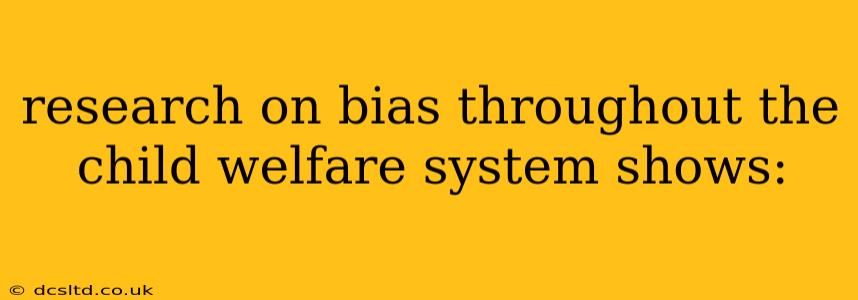Research on Bias Throughout the Child Welfare System Shows: A Deep Dive into Systemic Inequities
Research consistently reveals concerning biases permeating the child welfare system, leading to disproportionate involvement and outcomes for certain groups. This isn't about individual biases of individual workers, but systemic issues built into the system itself. This article will explore the multifaceted nature of this bias and its devastating consequences.
What are the main biases found in the child welfare system?
Several intersecting biases contribute to the disparities seen within the child welfare system. These include:
-
Racial Bias: Studies repeatedly demonstrate that children of color, particularly Black and Indigenous children, are disproportionately represented in the child welfare system compared to their white counterparts. This isn't solely due to higher rates of maltreatment, but rather, a combination of factors including implicit bias among caseworkers, differences in reporting practices, and socioeconomic disparities that can lead to more frequent investigations.
-
Socioeconomic Bias: Poverty is a significant risk factor for child welfare involvement. Families struggling with poverty often face more challenges meeting basic needs, increasing the likelihood of reports being filed against them, even when the circumstances may not constitute abuse or neglect. The stress of poverty can also make it harder for families to cooperate with child welfare investigations.
-
Bias Based on Disability: Children with disabilities are also overrepresented in the child welfare system. This is linked to several factors, including misunderstandings of behaviors associated with disabilities, a lack of adequate support services for families of children with disabilities, and the increased likelihood of reporting due to the challenging nature of caring for a child with disabilities.
-
Bias Based on Sexual Orientation and Gender Identity: LGBTQ+ families face unique challenges in the child welfare system. Negative attitudes and lack of understanding towards LGBTQ+ identities can lead to discriminatory practices, such as disproportionately high rates of removal of children from their homes, or a lack of culturally competent services.
How does implicit bias affect child welfare decisions?
Implicit bias refers to unconscious attitudes or stereotypes that can influence decisions without conscious awareness. Even well-intentioned caseworkers can be affected by implicit biases, potentially leading to unequal treatment of families from different racial or socioeconomic backgrounds. For example, a caseworker might unconsciously perceive certain behaviors differently depending on a family's race or socioeconomic status, leading to different conclusions about the level of risk to a child. This underscores the need for ongoing training and awareness-building around implicit bias within the child welfare system.
What are the long-term effects of bias in the child welfare system?
The consequences of bias in the child welfare system can be profound and long-lasting. Children who enter the system due to bias can experience:
-
Trauma: Removal from their families and placement in foster care can be incredibly traumatic, particularly for young children. The instability and potential for multiple placements can significantly impact their emotional and psychological well-being.
-
Educational Disruptions: Frequent moves and unstable living situations can disrupt a child’s education, negatively affecting their academic performance and future opportunities.
-
Mental Health Issues: The stress and trauma associated with involvement in the child welfare system can increase the risk of mental health problems, such as anxiety, depression, and PTSD.
-
Intergenerational Trauma: The effects of bias in the child welfare system can extend across generations, as children who experience trauma may face similar challenges in their own families.
What steps can be taken to reduce bias in the child welfare system?
Addressing bias requires a multi-pronged approach, including:
-
Increased Cultural Competency Training: Caseworkers need extensive training on cultural competency, implicit bias, and trauma-informed care.
-
Data Collection and Analysis: Regularly collecting and analyzing data on child welfare involvement by race, ethnicity, socioeconomic status, and other relevant factors is critical to identify disparities and track progress.
-
Community-Based Support Services: Expanding access to community-based support services, such as parenting education, mental health services, and substance abuse treatment, can help prevent unnecessary child welfare involvement.
-
Increased Focus on Family Preservation: Prioritizing family preservation efforts and providing families with the support they need to keep their children safely at home should be a core principle.
-
Accountability and Transparency: Implementing mechanisms for accountability and transparency within the child welfare system can help ensure that decisions are fair and equitable.
Addressing bias in the child welfare system is a complex and ongoing challenge, but it is essential to create a more just and equitable system that protects the well-being of all children. By understanding the nature of these biases and implementing targeted interventions, we can move closer to a system that prioritizes the safety and well-being of all children, regardless of their race, socioeconomic status, or other characteristics.
